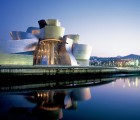Best architectural buildings in Bilbao
Best Bilbao architectural buildings
-
Bilbao Metro
The Metro Bilbao was designed by the renowned British architectural firm Foster and Partners, led by architect Norman Foster.
Foster's design for Metro Bilbao features a modern and efficient metro system that reflects the industrial heritage of Bilbao while incorporating contemporary design elements.
The stations of Metro Bilbao are known for their clean lines, use of glass, steel, and concrete, and a sense of spaciousness and efficiency.
Norman Foster's design for Metro Bilbao aimed to create a functional and aesthetically pleasing transportation system that would integrate seamlessly with the city's urban fabric.

-
Guggenheim Museum Bilbao
The Guggenheim Museum Bilbao, designed by the renowned architect Frank Gehry, is a masterpiece of contemporary architecture and a cultural icon in the city of Bilbao, Spain. Here are some key details about the museum and Gehry's design
Design Concept
The Guggenheim Museum Bilbao was designed by Frank Gehry and completed in 1997. Gehry's vision for the museum was to create a structure that would not only house art but also become a work of art in itself. The design aimed to evoke the maritime and industrial heritage of Bilbao, as well as the city's relationship with the Nervión River.
Iconic Form
The museum's most striking feature is its sculptural, undulating form that appears to flow like a ship on the river. Gehry used cutting-edge computer technology to design the complex curves and shapes of the building. The exterior is clad in shimmering titanium panels, which catch the light and change color throughout the day, creating a dynamic and ever-changing appearance.
Titanium Cladding
The use of titanium panels is one of the defining characteristics of the Guggenheim Bilbao. This material was chosen for its durability, lightness, and ability to withstand Bilbao's rainy climate. The panels were individually shaped and installed to create the seamless, organic form of the building.
Atrium and Interior Spaces
Inside the museum, visitors are greeted by a vast, light-filled atrium known as the "Grand Hall." This central space serves as the heart of the museum, connecting the various galleries and exhibition spaces. The interior features a mix of materials, including glass, limestone, and white plaster, creating a contrast to the titanium exterior.
Galleries and Exhibition Spaces
The museum's galleries are designed to accommodate a wide range of art installations and exhibitions. The spaces vary in size and shape, offering flexibility for curators to display a diverse collection of modern and contemporary art. Gehry's design allows for natural light to filter into the galleries through skylights and strategically placed windows.
Sculptural Staircases and Bridges
One of the most impressive interior features of the Guggenheim Bilbao is its sculptural staircases and bridges. Gehry designed these elements to create a sense of movement and flow throughout the museum. Visitors can ascend to different levels, providing unique perspectives of the artworks and the architecture itself.
Surrounding Landscape
The museum is situated along the Nervión River, and Gehry integrated the building into the surrounding landscape. The design includes outdoor spaces such as terraces, walkways, and a large reflecting pool. These areas offer visitors opportunities to enjoy the views of the river and the cityscape while interacting with the architecture.
Cultural Impact
The Guggenheim Museum Bilbao has had a profound impact on the city of Bilbao and the region of Basque Country. It has become a symbol of Bilbao's revitalization and transformation from an industrial city to a cultural hub. The museum attracts millions of visitors each year, boosting tourism and contributing to the city's economy.
Architectural Legacy
Frank Gehry's design for the Guggenheim Bilbao is widely regarded as a masterpiece of contemporary architecture. It has influenced subsequent museum designs around the world, inspiring architects to explore new possibilities in form, materials, and spatial experiences. The museum's success has also demonstrated the power of architecture to transform cities and create cultural landmarks.
The Guggenheim Museum Bilbao by Frank Gehry is a stunning example of contemporary architecture, characterized by its iconic form, titanium cladding, dynamic interior spaces, sculptural elements, and integration with the surrounding landscape. It stands as a testament to Gehry's vision and creativity, as well as the transformative impact of architecture on a city and its culture.

-
Zubizuri


